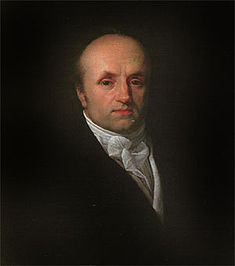 D’origine Prussienne Abraham Louis Breguet est né à Neuchâtel en Suisse le 10 Janvier 1747.
D’origine Prussienne Abraham Louis Breguet est né à Neuchâtel en Suisse le 10 Janvier 1747.
Sa carrière d’horloger commença au près d’un horloger à Versailles en tant qu’apprenti.
Horloger, mais également physicien il consacra sa vie à perfectionner les mouvements de montres perpétuelles, inventa des échappements de toutes sortes et est le premier a employer les rubis en horlogerie pour les parties frottantes.
On lui doit entre autres la montre bracelet mais surtout le tourbillon.
Scientifique avant tout, ses inventions on été primordiale dans la navigation, l’astronomie et la physique, ainsi on lui doit un grand nombre de chronomètres, de pendules astronomiques, d’horloges marines et de thermomètres métalliques.
Son séjour en Angleterre pendant la période de la Terreur fut décisif, en effet il consacra ces deux années à l’étude de la mécanique qui lui permirent plu tard de perfectionner son art à un point très poussé.
L’entreprise Breguet fut fondée en 1775. Chevalier de la légion d’honneur, horloger de la marine française, membre de l’académie des sciences, il passa ses 76 ans de vie a se surpasser et apporta à l’horlogerie d’innombrables découvertes, autant sur le plan technique que esthétique.
On compte parmi ses clients Marie-Antoinette, Napoléon Bonaparte, Talleyrand, l’impératrice Joséphine, la reine Victoria et Winston Churchill et bien d’autres.
La manufacture Breguet rejoint le groupe Swatch en 1999.
Historique
 1775 A L Breguet s’installe à son compte quai de l’Horloge sur l’Ile de la Cité à Paris.
1775 A L Breguet s’installe à son compte quai de l’Horloge sur l’Ile de la Cité à Paris.
 1780 Lancement des première montres automatiques dite Perpétuelle, dotée d’un mécanisme dit « à secousses ».
1780 Lancement des première montres automatiques dite Perpétuelle, dotée d’un mécanisme dit « à secousses ».
 1783 Invention du ressort-timbre pour les montres à répétition . Commande de la montre dite de Marie-Antoinette, terminée en 1827 après plusieurs interruptions. Cette oeuvre est considérée comme la première montre à Grande Complication de l’histoire de l’horlogerie.
1783 Invention du ressort-timbre pour les montres à répétition . Commande de la montre dite de Marie-Antoinette, terminée en 1827 après plusieurs interruptions. Cette oeuvre est considérée comme la première montre à Grande Complication de l’histoire de l’horlogerie.
 1786 Développement des cadrans guillochés.
1786 Développement des cadrans guillochés.
 1789 Invention de la clef à criquet dite «Clef Breguet »
1789 Invention de la clef à criquet dite «Clef Breguet »
 1790 Invention du pare-chocs.
1790 Invention du pare-chocs.
 1795 Développement du calendrier perpétuel. Développement du spiral Breguet, utilisé encore couramment dans l’Horlogerie.
1795 Développement du calendrier perpétuel. Développement du spiral Breguet, utilisé encore couramment dans l’Horlogerie.
 1796 Montre à une aiguille dite de souscription.
1796 Montre à une aiguille dite de souscription.
 1798 Dépôt du brevet de l’échappement à force constante. Première pendule sympathique qui permet de mettre à l’heure (et plus tard de remonter) une montre spécialement conçue.
1798 Dépôt du brevet de l’échappement à force constante. Première pendule sympathique qui permet de mettre à l’heure (et plus tard de remonter) une montre spécialement conçue.
 1799 première montre à lecture tactile.
1799 première montre à lecture tactile.
 1801 Brevet du «régulateur à tourbillon »
1801 Brevet du «régulateur à tourbillon »
 1810 Première montre-bracelet pour la Reine de Naples
1810 Première montre-bracelet pour la Reine de Naples
 1812 Première apparition des cadrans à tour d’heures excentré.
1812 Première apparition des cadrans à tour d’heures excentré.
 1815 Mise au point du chronomètre à double barillet.
1815 Mise au point du chronomètre à double barillet.
 1820 Montres à doubles secondes ou « chronomètre d’observation », ancêtre du chronographe moderne
1820 Montres à doubles secondes ou « chronomètre d’observation », ancêtre du chronographe moderne
1822 Chronographe encreur
 1823 mort d’Abraham Louis Breguet, le 17 septembre. Il a 76 ans.
1823 mort d’Abraham Louis Breguet, le 17 septembre. Il a 76 ans.
 1830 première montre à remontoir sans clef.
1830 première montre à remontoir sans clef.
1926 Montre sans aiguille, à cadran tournant et heures sautantes par guichet.
1939 Brevet du « garde temps sidéral »
1954 Chronographe bracelet militaire type XX doté de la fonction retour en vol.
1976 Transfert des ateliers à la Vallée de Joux. Dès lors, la totalité de la production sera faite en suisse.
 1988 Montre-bracelet à tourbillon.
1988 Montre-bracelet à tourbillon.
 1991 Brevet de la montre-bracelet à équation du temps perpétuelle.
1991 Brevet de la montre-bracelet à équation du temps perpétuelle.
 1997 Brevet d’un mouvement de la montre rectiligne avec calendrier Perpétuel.
1997 Brevet d’un mouvement de la montre rectiligne avec calendrier Perpétuel.
 1998 Lancement du plus petit mouvement chronographe automatique au monde.
1998 Lancement du plus petit mouvement chronographe automatique au monde.
1999 La manufacture Breguet intègre le groupe Swatch
2002 Brevet pour le mécanisme de la phase de lune (Reine de Naples)
 2003 Deux brevets pour le Réveil du Tsar : le verrouillage de la fonction réveil et l’indexation du réveil sur le fuseau horaire
2003 Deux brevets pour le Réveil du Tsar : le verrouillage de la fonction réveil et l’indexation du réveil sur le fuseau horaire
2004 Balancier en titane
2005 Trois brevets pour le nouvel échappement à détente Breguet Lancement de la ligne Tradition
2006 Montre comportant au moins deux systèmes réglants (Double Tourbillon)
Abraham Louis Breguet was born in Neuchâtel , Switzerland on January 10th 1747.
His career of watchmaker began beside a watchmaker in Versailles as apprentice.
Watchmaker and physicist he dedicated his life to perfect the movements of Perpétuelle watches, invented escapements of all sorts and is the first has use the rubies in watchmaking.
He was the inventor of the wirstwatch and also the “tourbillon”.
As a scientific,his inventions was a vital in the navigation, the astronomy and the physics, so he was the father of a big number of chronometers, astronomical pendulums, navy clocks and metallic thermometers.
His stay in England during the period of “Terreur” was decisive, indeed he dedicated these two years to study mechanical that let him perfect his art to a very advanced point.
the factory Breguet was founded in 1775. Knight of the Legion of Honour , watchmaker of the French navy, member of the sciences academy, he spent his whole life to surpass himself and contributed to the watchmaking with countless discoveries.
Some of his famous customers was Marie-Antoinette, Napoléon Bonaparte, Talleyrand, empress Joséphine, queen Victoria and Winston Churchill and many others.
The Breguet factory join the Swatch group in 1999.
A L Breguet
- 1775 A. L. Breguet sets up his own business on l’Horloge sur l’Ile de la Cité in Paris.
- 1780 Launch of the first self-winding watches known as ‘perpétuelles’, with an oscillating weight and two going-barrels.
- 1783 Invention of gong spring. Design of hands with hollowed-out points known as ‘Breguet hands’ and of Arabic numerals known as ‘Breguet numerals’.
- 1783 Commissioning of the so-called Marie-Antoinette watch which, after numerous interruptions, was completed in 1827. It is acknowledged as being the first Grande Complication.
- 1786 The first guilloché dials.
- 1789 Invention of the ratchet key known as the ‘Breguet key’.
- 1790 Invention of the ‘pare-chute’ anti-shock device, to reach its final form in 1806.
- 1795 Development of perpetual calendar. First description of the ‘sympathique clock’ in a letter to his son.
- 1796 Sale of the first ‘souscription watch’, a new development launched the following year with the aid of a publicity brochure.
- 1798 Patent for the constant force escapement. Musical chronometer.
- 1799 The first tact watch.
- 1801 Patent of the ‘tourbillon regulator’ (26 June).
- 1810 Manufacture of the first wristwatch, commissioned by the Queen of Naples and completed in 1812.
- 1812 First appearance of dials with off-centre hour ring.
- 1815 Final adjustments made to the marine chronometer with two going-barrels.
- 1820 Invention of the montre à doubles secondes or ‘observation chronometer’, forerunner of the modern chronograph.
- 1822 Ink chronograph.
- 1823 Death of A.-L. Breguet on 17 September, aged 76 years.
- 1830 First watch with keyless winding.
- 1926 Watch without hands, with a rotating dial and jumping hours shown in an aperture.
- 1939 Patent of the sidereal timekeeper (28 February).
- 1954 “Type XX” military wrist chronograph with flyback hand.
- 1976 Transfer of the Breguet workshops to the Vallée de Joux. Henceforth, the entire production is based in Switzerland.
- 1988 Tourbillon wristwatch.
- 1991 Patent for the wristwatch with perpetual equation of time.
- 1997 Patent for a straight-line perpetual calendar watch movement with instant year-jump (15 May).
- 1998 Launch of the world’s smallest self-winding chronograph movement.
- 1999 Groupe Horloger Breguet is incorporated into Swatch Group.
- 2002 Patent for the moon-phase mechanism of the “Reine de Naples” watch.
- 2003 Two patents for the “Le Réveil du Tsar” watch: the locking mechanism for the alarm function, and coordination of the alarm to local time.
- 2004 Titanium balance.
- 2005 Three patents including the new Breguet detent escapement. Launch of the “Tradition” line.
- 2006 The “Double Tourbillon” watch.

